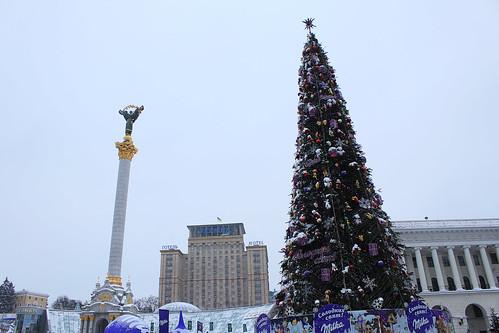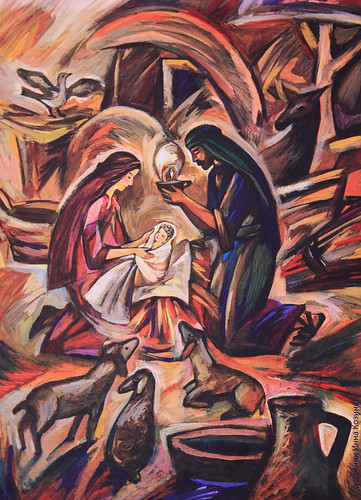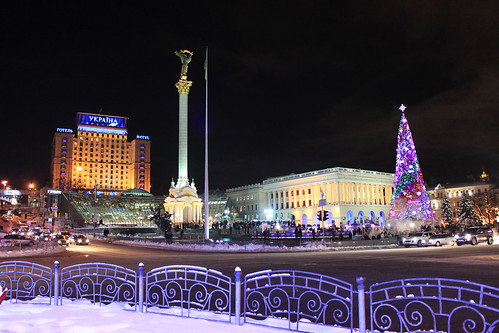
We will be spending Christmas day with our neighbor Olya and her family enjoying a meal that is sure to have way more food than any of us could ever eat. This will be our last Christmas in Ukraine and I wanted to share a little about Ukrainian Christmas with all of our friends and family outside of Ukraine.
Christmas in Kyiv
Here is an excerpt from The Worldwide Gourmet about Ukrainian Christmas tradition.
"Sviata Vechera - A feast of twelve meatless dishes
The rich traditions of Ukraine, dating back through more than a millennium of Christianity to pagan times, have been carried throughout the world to wherever the Ukrainian people have settled. And there is probably no occasion when these ancient customs are held more dear than at Christmas, when families reenact age-old observances that symbolize their deep spirituality, love of family and attachment to the land.
Traditionally Ukrainians have followed the Julian calendar, in which Christmas falls on January 7. These days many Ukrainians in North America join in the holiday festivities surrounding December 25, but continue to place a special religious emphasis on the traditions that mark Ukrainian Christmas, thirteen days later. The days leading up to the celebration are marked by spiritual preparation and fasting. The menu for the "holy supper," or sviata vechera, of Christmas Eve does not contain any meat or dairy products. The meal centres instead around grains, fish, vegetables and fruits; vegetable fats or oils are used instead of butter.
Many of the rites observed during the Ukrainian Christmas Eve meal are very ancient, going back to the pre-Christian era. Early Christians adopted these customs for themselves and invested them with new religious significance. To prepare for the meal, some hay is placed on or under the dining table, representing the manger of the baby Jesus. The table is then laid with the family's finest embroidered tablecloth, or even two tablecloths: one to represent the living members of the family, and one the dead. An extra place is always set for the souls of deceased relatives. Given place of honour in the centre of the table is the Christmas bread or kolach, consisting of three stacked rings. The number represents the Holy Trinity, and the circular shape eternity. A candle is placed in the centre to symbolize Jesus, the light of the world."
"The meal begins once the children of the family sight the first star in the evening sky, recalling the journey of the wise men towards Bethlehem. On farms, the head of the family customarily carries a sheaf of wheat called a didukh into the house, representing the family's ancestors, and places it under the household icons. (Outside, in the barn, animals are traditionally given an extra ration, honouring their role in the first Christmas.) In modern urban celebrations of the Christmas Eve meal, the sheaf may be replaced by a few wheat stalks decorating the table. The meal begins with a prayer and the traditional Christmas greeting "Khrystos rodyvsya!" (Christ is born), to which all respond "Slavite yoho!" (Let us praise him.)
Twelve dishes are served, representing the twelve apostles. Wheat shows its importance once again, for it is the main component of the special first course, called kutia, boiled kernels sweetened with honey and flavoured with poppy seeds or nuts. All members of the family must partake of a little kutia, which symbolizes prosperity for the coming year. An old superstition holds that if some of the wheat sticks to the ceiling when a spoonful of kutia is thrown into the air, the new year will be a prosperous one. These days, your hosts might prefer that this particular tradition be omitted!
Next comes soup: in this case, borshch, the famous beet soup, which for this Christmas Eve meal is made without meat or meat stock. Besides beets, the borshch may contain onions, carrots, cabbage and potatoes.
The central part of the meal is centered around fish and vegetable dishes. Fish is served baked or fried, in aspic, or pickled (perhaps whitefish or herring). An integral part of any Ukrainian meal is pyrohy or varenyky, dough dumplings filled with potato and onion, or perhaps sauerkraut or even fruit. Then there are usually two varieties of holubtsi, cabbage rolls: one stuffed with a savoury rice filling, the other with buckwheat.
There is an assortment of other vegetable side dishes: white beans mashed with onions and garlic; kapusta, or sauerkraut with onions; salads or perhaps marinated beets or mushrooms.
Towards the end of the meal, a compote of dried fruits is brought out. It may include prunes, apricots, apples and figs that have been soaked overnight and cooked with honey.
For dessert, there is an assortment of pampushky, little deep-fried pastries containing various fillings such as poppy seed or dried fruit.
This sacred and festive meal goes on for a long time. For the Ukrainian family it not only brings together decades of memories and reminiscences of beloved family members, but is also a link to centuries of proud tradition. Those gathered around the table are reluctant to get up once the meal has ended and so the family members and guests prolong the celebrations late into the night with the singing of Christmas carols."
Maidan Nezalezhnosti (Independence Square) in Kyiv




No comments:
Post a Comment